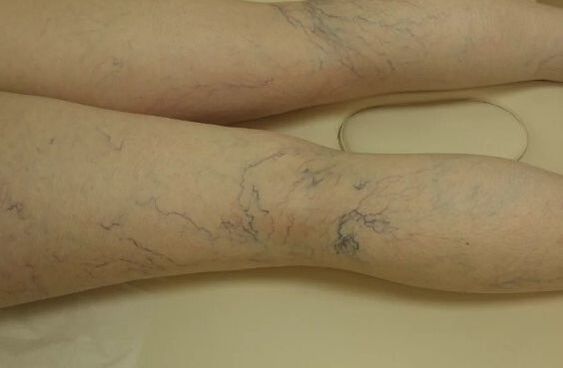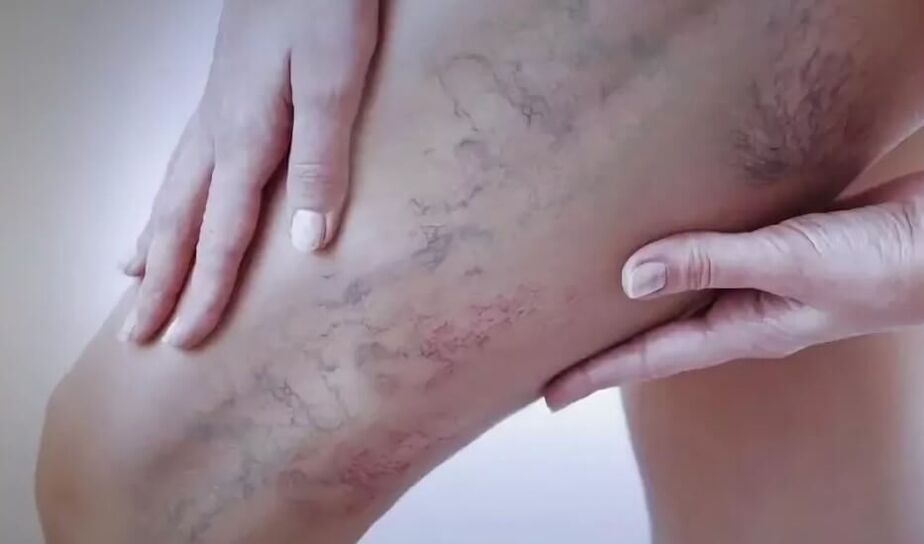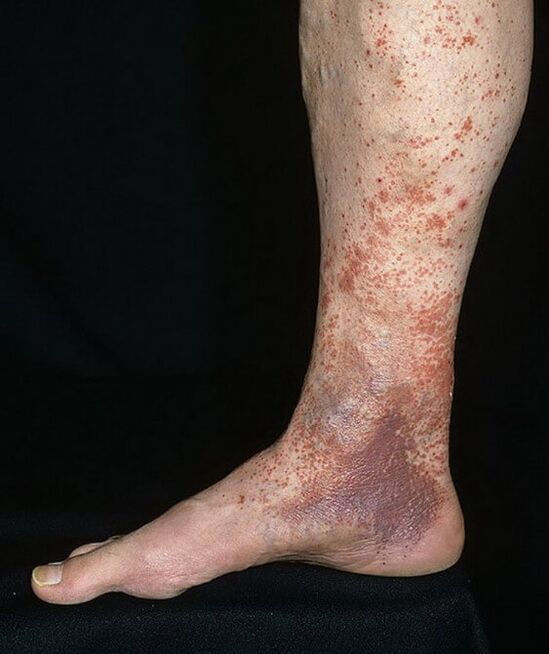The varicose veins on the legs are a chronic change in the flow of blood, due to the influence of the mechanical, toxic, traumatic or other factor.
To better understand the essence of the pathological process, you must refer to anatomical information.
The lower limbs are provided in two main ways:
- On the arterial branches.They carry blood rich in oxygen, which simply provides cells with useful compounds.
- Through the veins.Liquid tissue tolerates carbon dioxide and unnecessary substances for treatment, in the opposite movement of the blood of the structures, the veins are involved.
It should be noted that different types of blood vessels are not connected or reported, the systems are completely closed.
Blood through the veins moves strictly in one direction.The muscle layer of these structures is quite low, all the work falls on special valves.They are like partitions, doors that do not pass the liquid fabric in the opposite direction from the application.
In the context of the increase in venous pressure, injuries, damage and other factors, the valves weaken.The blood retreats, the load on the walls of the blood vessels increases.Vienna wears out several times faster.
Under the mechanical effect, the numbering structures modify their properties and their sizes.Varicosis itself begins.
This disease is characterized by deformations of the blood vessels, a decrease in their functional activity, the protruding type of the walls over the entire length.
Varicosis is dangerous insofar as over time, leads to a break in the vein, the formation of blood clots, the death of local tissues.The treatment should start immediately, from the moment the pathological process is detected.
A characteristic of a disorder is a relatively unusual progression.The main contingent of patients is men and women over 18.
Despite the relatively unusual development, the disease behaves unpredictably.Never say in advance when the critical complications develop.
A doctor who treats illness is a phlebologist.
Development mechanism
The pathological process is based on heterogeneous factors, if generalized and composed of an approximate image, the options will be as follows:
Mechanical influence
Increase in physical activity on leg veins.It is found, for example, with intensive sports.The more common options are characteristics of professional activity (manufacturers, teachers, cooks and others suffer), the increase in body weight, because the load on the legs develops.
There is every chance of overcoming the pathological process in time.The main thing is to eliminate the abnormal factor.
Traumatic lesions of surrounding tissues
Not the veins themselves, but the areas around.Bruising of sweet structures, muscles, ligaments, partial and complete fractures.
There are two reasons for the development of varicose veins: the compression of blood vessels with modified tissues, and also an uneven redistribution of the load on the lower limbs.
Interestingly, varicose veins can also be diseases of the musculoskeletal system: arthritis and similar.
Compression of leg legs
This refers to an external influence.The violation of blood circulation often causes patients themselves with their own unreasonable actions.
For example, wearing tight tights or socks is affected.Women who are ready to bring health are particularly similar.
When compressing the legs in the region, which are below the compression site, are subject to stagnant processes.The venous-lymphatic exit is considerably disturbed.This leads to quickly progressive varicose veins.
There are cases where the pathological process started later, years later of a negative influence.
Hormonal balance violations
Disorders in the production of substances in the thyroid gland, adrenal glands and pituitary gland are affected.
Change can affect other compounds: Hormones of the reproductive system, androgens, estrogens.They partially regulate the tone of large vessels, veins and arteries.
Genetic characteristics
Infused history, according to research, plays almost the main role in the development of the pathological process.It is not a trigger, but a clear premise that increases the probability several times.
Of course, the presence of a parent who suffered from varicose veins is not a guarantee of the development of the pathological process, but the probability is significantly higher.
It is necessary to respect the prevention rules in order to minimize the risks.
Hypovitaminosis
For normal work, the regeneration of veins, arteries, ascorbic acid is necessary.In addition, group B vitamins, E, D. There can be no normal restoration of blood vessels without them.They wear out quickly, lose their old elasticity.
If the cancer state lasts long enough, from several months, to avoid changes in the veins.
The disease develops faster than usual, progression to a pronounced and dangerous stage takes only a few months, as much of a few years.
Congenital anomalies
The views, as a rule, do not develop in isolation.Other differences can be found.Therefore, diagnoses are not problems.
Natural states
Pregnancy, severe birth, characteristics of the hormonal background in adolescence or closer to old age.
There are other less common mechanisms.For example, poisoning, exposure to the body of radiation and others.The most common are named.
Varices are a disease characterized by a deviation system: deformations of the veins, aneurysm formation, stars, slimming of the internal lining.The influence of a group of pathogenetic factors is possible.
Classification
Unity methods are linked to the stage of the pathological process, its form.On everything in order.
The technique adopted in medicine distinguishes three degrees of disease development:
- Paid.Symptoms as such are absent, the patient does no complaint regarding health.The pathological process at the very beginning of its development.But there are already visible signs: the dilated veins pass through the thickness of the skin.For several years, the violation will go to a new stage.
- Subjection.The clinical signs of the varicose vessels are clearly expressed.Among them, you can distinguish the pain, the gravity of the legs, the feeling of pouring goosebumps, weakness, convulsions at night.After rest, they come to nothing.Visible demonstrations are also present.You can make a diagnosis without problems.
- Decompensation.In addition to the symptoms already mentioned, additional: leg numbness, loss of sensitivity, common rash, constant itching and burning areas of the lesion.
There are real risks of tissue necrosis, thrombosis.The treatment is urgent, otherwise - not to pass the disability.
Standing

There is a generally accepted international typography of the pathological process in steps (classes):
- 0. The visible symptoms of the disorders are minimal.Patients speak of severity in the lower limbs.This phase can last indefinitely.
- 1. The stars are formed on the surface of the legs, the veins develop and become clearly visible.The clinic is still the same.The maximum - episodes of night crises develop, which are interrupted as quickly and suddenly as they started.
- 2. The clinical signs are identical.With a visual assessment of the lower limbs, the doctor reveals changes of visible varicose veins from the veins: they branch, exceed, form complex deformations.
- 3. From this stage, the pronounced edema begins.
- 4. The rashes appear, the itching of varicose dermatitis.The skin above the surface of the lesion changes the shadow into a dark tint, compact considerably and dry.It becomes thin, because any mechanical effect causes painful and deep comb.
- 5. Small erosions appear.
- 6. Complete trophic ulcers are developing.
For the complete training of the pathological process, from 0 to the 6th stage, it takes up to several decades.
Symptoms
The clinical picture depends on the disorder phase.If you have an average list of events, the list will be:
- Heaviness in the legs.Above all, after a mechanical load, a long -term working day.Walking, standing in a place becomes problematic.Over time, the symptom is only intensifying, which indicates the progression of the violation and allows you to suspect the varicose veins at the very beginning.
- Intolerance to physical activity.At first, the patient is unable to walk for a long time, then stand up.If you start a disorder, it will only get worse.A person will not be able to climb the stairs without long breaks, breaks.This is due to venous lymphatic stagnation in the extended veins.
- Pain of different intensities.At the initial stage, are absent.Then, after a few months or years, the severity of the demonstration increases.The stupid and uncomfortable sensations begin.
They intensify after physical activity, with a clear change in body position.
 Through the last stages of the disease, the symptom remains constantly with the patient, does not disappear at all.
Through the last stages of the disease, the symptom remains constantly with the patient, does not disappear at all. - Visual changes in ships.They look like abnormal ramification, the formation of stars on the legs.These demonstrations clearly indicate the start of varicose vessels.Therefore, diagnoses over time become easier.It remains only to clarify the location of changes and their diploma.
- Swelling.They gradually start, approximately with the second or third stage of the pathological process.First - at the end of the day.Pass after a night of rest.Then, the volume changes are constantly preserved, do not finish at all.As a rule, the signs relate first, then the other leg.
- Cramps in darkness.The violation of the tone of the muscles, the cramps, is one of the first signs of varicose veins, which is due to the slowdown in the venous lymphatic flow, tissue trophies and cellular breathing.
Cramps in the legsThey prevail at night, accompanied by very serious pain.The patient cannot stand on the affected leg during the day, or even several.Gradually, the frequency of spasms does not become higher.
- Skin itching.An alarm sign of varicose veins, which characterizes progressive dystrophic disorders.At the initial erosion stage, there are no ulcers yet.But it's a matter of time.
- Change the shadow of the dermis.Hyperpigmentation.Darkening of the surface of the skin.Closer to the final phase of the pathological process, the lower leg acquires a rich shade of raspberry.
A symptom characteristic of the varicose veins of the lower limbs is the seal of the skin above the lesion, which is associated with raw scars of tissue below the surface of the epidermis, the external layer of the skin.
- The formation of a rash.Varice dermatitis, called.It is a pre-neck sign for the final stage of the pathological process.The small papules are very itchy, they do not allow the patient to live normally.Complications are possible, secondary infection of the surfaces of the wounds.
- Trophic ulcers.A clinical sign, which is characterized by the formation of large erosion, foci of tissue.First - superficial, then fat.And there is not far from necrosis.Therefore, you cannot shoot with treatment.

The symptoms of varicose veins are caused by an alteration of tissue trophies, venous output disorders, epidermal destruction and subcutaneous fats.
Clinical signs are progressing slowly because it is likely to start treatment in a timely time.The patient's task is not to miss an important point.
Profile specialists who need to contact - Phlebologist, dermatologist, hematologist.
Reasons
Varicosis develops following a combination of factors or the influence of a, but of a very intense provocateur.
There are several options:
- Physical activity.Long walking, motionless standing.Usually, such a moment is associated with the characteristics of professional activity, lifestyle.
- Injuries.Fractures, full or partial.Also bruise, damage to soft tissue.
- Hypovitaminosis.The absence of substances in group B, E, D, ascorbic acid.
- Genetic factors.Hereditary moments, overwhelmed family history.The probability of a pathological process increases, but nothing guarantees that the disease will begin.
- Myosites in the bottom of hypothermia, physical overload.
- Arthritis.Joint inflammation.
- Hormonal imbalance.Lack or excess of the joints of the thyroid gland, adrenal glands, pituitary gland.
- Flebititis of leg ships.The cause of varicose veins in the inflammation of veins of an infectious or non -fertical nature.
- Vasculitis of the vessels of the lower limbs.Autoimmune lesions.
- Pregnancy.Since the hormonal background changes and the load on the legs, the entire musculoskeletal system is developing.
- Peritic period.Until about 17 to 20 years.
- MENOPAUSA (Andropauza).Klimax.The progressive attenuation of the reproductive function.
The causes of varicose veins can be traumatic, inflammatory, degenerative, dystrophic.
Diagnosis
Flagers are engaged in the exam.It is only then if necessary, other specialists are connected.Among the methods:
- Oral survey.The doctor must understand what complaints the patient himself is made.
- HANG -UP collection.The study of the likely origin of the problem.
- Visual assessment of the legs of the legs.On the grounds, it is possible to study the nature of the pathological process, its characteristics.
- Palpation.Physical technique.
- UZDG.Dopplerography of the legs of the legs.Allows you to detect anatomical changes in the lower limbs, differences in blood flow speed.Used as main methodology.It allows you to quickly make a diagnosis and study the degree of disorder.
- X -Ray.If there is such a need.
- In particularly difficult cases, the doctor prescribes an MRI.
The development of varicose veins on the legs is a sufficient and visually characteristic sign of expansion of the veins of the lower limbs, it can be diagnosed on it.Then it remains to determine the severity of the pathology.
Treatment
Therapy at the initial stages is conservative.In total, three correction approaches can be distinguished.
Medicine.It is a systematic administration of drugs.The means are prescribed which stimulate microcirculation, blood circulation, valves, protect the vessels from a new tissue destruction.
Among the groups of funds:
- Venotonie.
- Angioprotectors.
- Vitamins, antioxidants.
In addition, physiotherapy, the treatment of the exercise, the massage is actively prescribed, the wearing of compression knitting is shown.
A conservative technique is used in the initial stages of the disease or for the auxiliary correction in the other main method.
A mini-invasive approach.The treatment of varicose veins of the lower limbs implies the destruction of the vessels affected using a special sclerosing drug, liquid nitrogen.
The methodology of sclerotherapy or radiofrequency removal is used in pronounced stages, but not critical of the disease.
Surgical approach.Treatment of varicose veins on the legs requires the use of laser, electric currents or direct excision of affected ships - Phleectomy.
The doctor suppresses half-structure, the pads finish healthy areas, forming anastomosis.Very soon, the blood flow is restored.
There are several operational techniques.The choice remains with the doctor.
Forecast
The varicose veins on the legs are completely cured in the first three stages, then there are risks of complications, irreversible changes in leg tissue: ulcers, muscles and others.Although survival is still almost 100%.
In the context of necrosis, common erosion, sepsis, the probability of death increases ten times.
In general, the disease is well treated.
Prevention
The preventive measures are very simple, the main thing is to adhere to them strictly:
- DIVES.Every hour or two, you have to crush.Especially with a sitting / standing lifestyle.
- Wearing comfortable shoes, socks, tights.Preferably from natural materials.
- Use of compression knitting.
- Light physical activity.Swim, run.The main thing is not to overwhelm.
- Appropriate nutrition.More vitamin products.
- Optimal consumption mode.1.5-2 liters per day.
The absence of liquid affects negatively, the blood thickens, motivates through the vessels, the pressure in the venous network increases.
Consequences
Complications can be fatal.Among the options:
- Muscular dystrophy.
- Paresis.Partial loss of sensitivity
- The formation of ulcers with the probability of secondary infection.
- Fabric necrosis.Gangrene.Especially with the defeat of the deep veins.
- Bombosa of the legs, thrombophlebititis.
- Sepsis.Blood poisoning.
- Disability.
The varicose veins of the lower limbs are a pathological change in the form, the structure, the elasticity of the legs of the legs (and not only) with the loss of muscle functions.
The disease develops slowly, but without quality treatment, the result will be deplorable.























